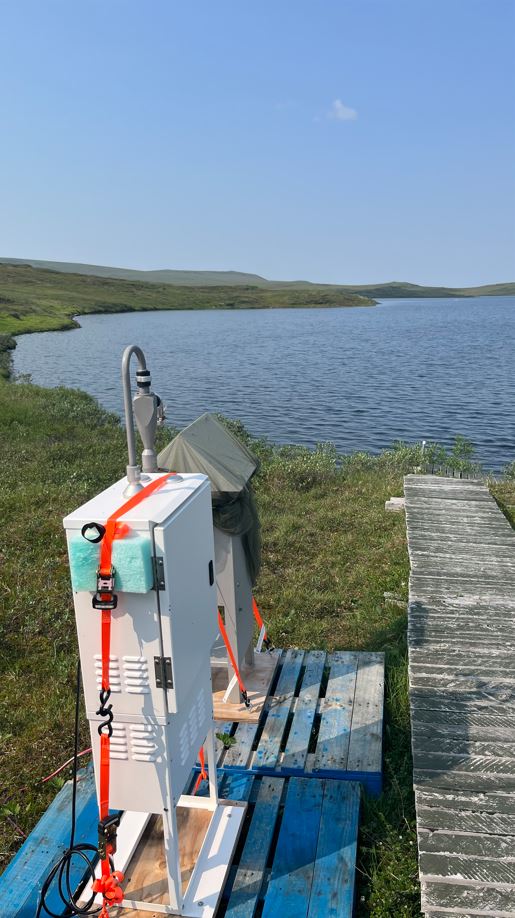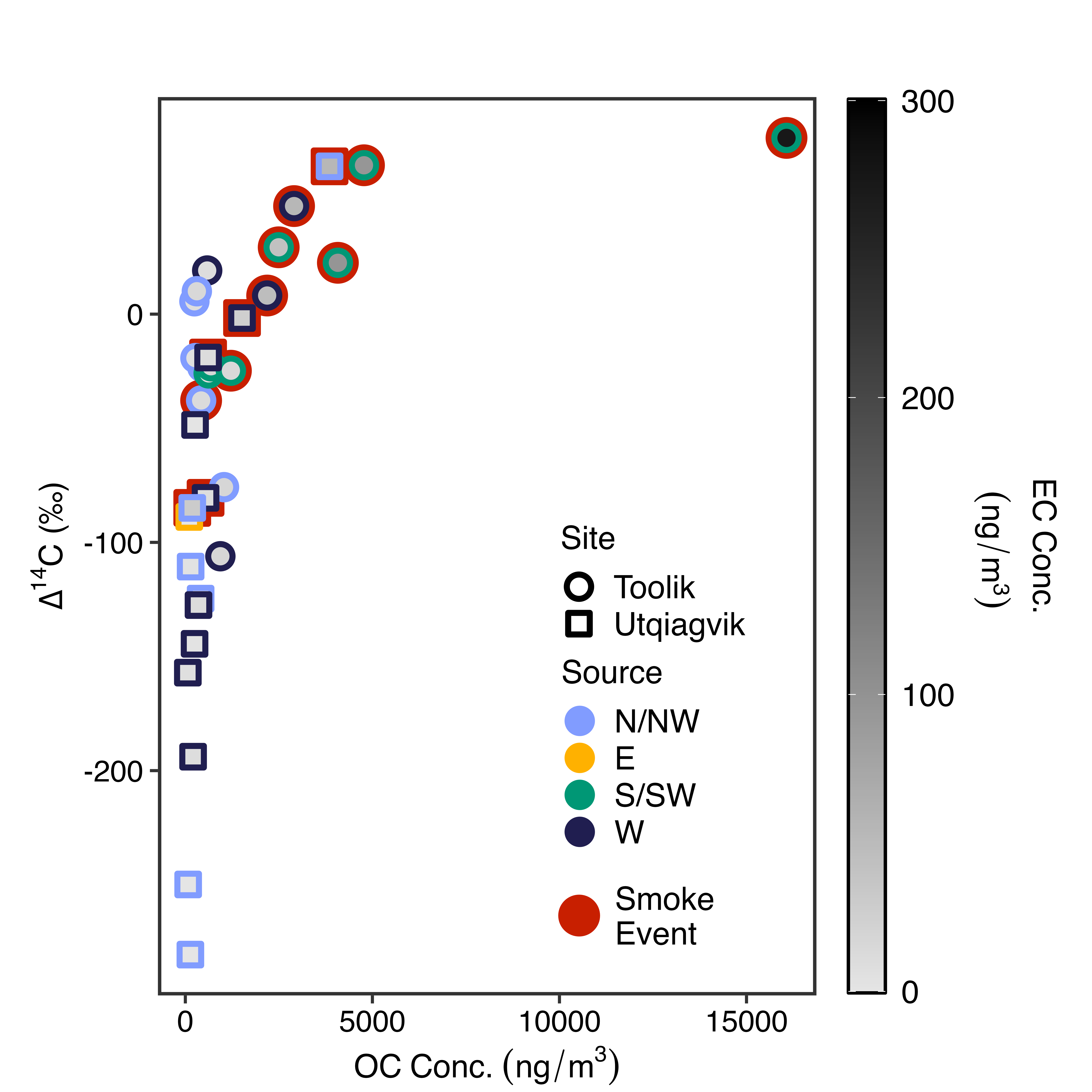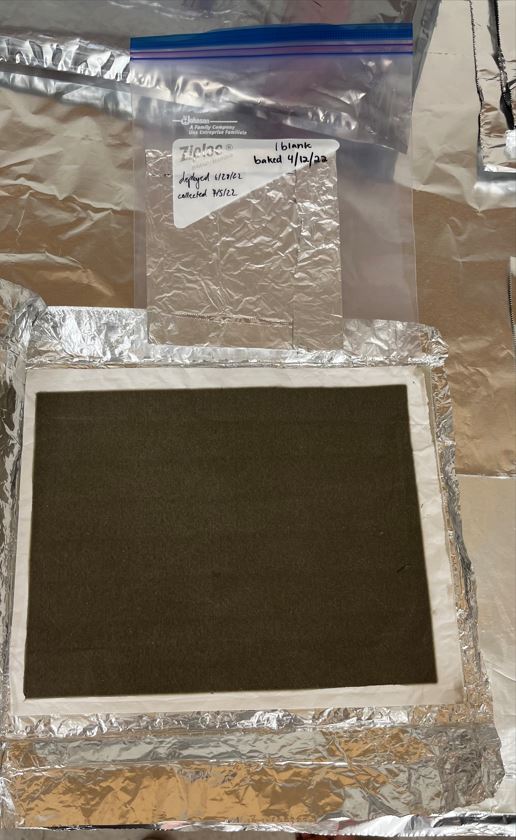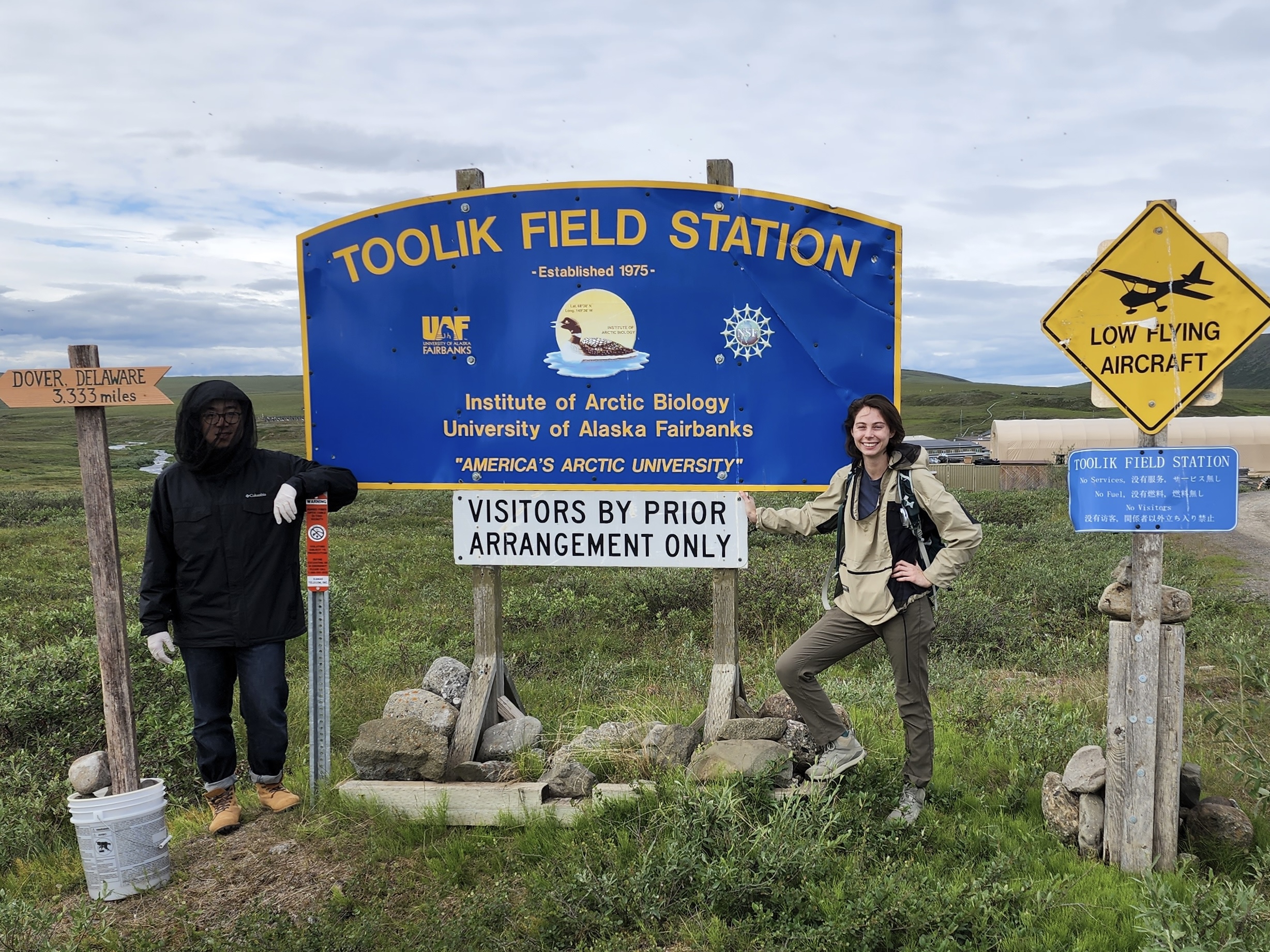Highlight: “Satellites and drones are tools that can be used to answer so many questions without the need for significantly disturbing the landscape further.” – Allison Welch
Background

Allison Welch collecting a total suspended particle (TSP) sample from the high volume TSP sampler. Photo credit: Claudia Czimczik.
Allison’s passion for environmental science began at an early age, sparked by working with trail maintenance crews in high school. This led her to pursue a Bachelor’s degree in environmental science at the University of Florida, minoring in wildlife ecology and conservation and geology. Diverse research experiences throughout her undergraduate degree led her to the University of California, Irvine, where she is currently a PhD candidate working with Dr. Claudia Czimczik on the Biogenic Emissions and Aerosol Response on the North Slope (BEAR-oNS) project, conducting field work at Toolik Lake in Northern Alaska. Allison notes that she is grateful for the Indigenous people who inhabit and steward this land—the Nunamiut, Gwich’in, Koyukuk, and Iñupiaq peoples.
Research Interests

Two aerosol samplers at Toolik Field Starion. The one in front is a medium-volume sampler from which the data collected was not included in this published dataset. The one behind is the high-volume sampler that was used to collect part of the data in this dataset (outfitted with a mosquito net to deter bugs). Photo credit: Allison Welch.
Allison’s research aims to understand the changing Arctic carbon cycle by characterizing summertime carbonaceous aerosols (particles) in the Arctic atmopshere. She explains that “changes in temperature and precipitation are drastically changing the (Arctic) landscape, to the point where researchers have observed increased plant growth and primary production, thawed permafrost, increased severity and frequency of wildfires, and other changes which drastically alter the carbon cycle”. While primary aerosols can be a product of the combustion of fossil fuels or biomass from wildfires, secondary aerosols can come from the oxidation of volatile compounds emitted by plants and are often temperature-dependent. Allison explains that “projected changes in carbonaceous aerosols during the summer will impact atmospheric chemistry and climate, but our understanding of these processes is limited by sparse observations.” This sparked a collaborative research effort studying the composition and source of carbonaceous aerosols in the Arctic.

Delta^14C vs. organic carbon (OC) of total suspended particles (TSP) samples at Toolik (circles) and at Utqiagvik (squares). Elemental carbon (EC) concentration is represented by shading of each point. The major source of air to each sample is represented by the outline color. Samples that were affected by wildfire smoke events determined using NOAA Hazard Mapping System (HMS) are represented by an additional red outline.
Dataset
As part of this research effort, Allison and colleagues collected samples from two study sites (Toolik Lake & Utqiagvik) in Northern Alaska in the summers of 2022 and 2023. Results of this study included a new dataset hosted by the Arctic Data Center- Characterization of summertime carbonaceous aerosol on the North Slope of Alaska (Toolik and Utqiaġvik), 2022–2023, and revealed that most of the carbon in these Arctic aerosols is organic (not elemental) and is sourced from modern sources (not fossil fuel sources). Additional results indicated that carbonaceous aerosol concentrations were, on average, twice as high at Toolik (inland site) than at Utqiagivik (coastal site) and that significant smoke events from boreal forest fires were observed during both summers at both sites, “contributing significant pulses of carbonaceous aerosols to the region”.
Methods and Technology

One of the total suspended particle (TSP) samples taken on a quartz filter in June of 2022. This sample was affected by wildfire smoke and thus the TSP concentration was higher than average. Photo credit: Allison Welch
As part of this project, scientists examined total carbon (TC), organic carbon (OC), and elemental carbon (EC) fractions in total suspended particles (TSP). High-volume TSP samplers were deployed at each study site, which had average flow rates of 1.1 cubic meters per minute. TSP samples had a duration of about one week (i.e., the quartz filters were being exposed to flow for a week at a time before being collected and starting a new sample) and OC and EC fractions were quantified. Allison explains that “We investigated the dominant sources of carbonaceous aerosol using air mass backward-trajectories from the NOAA HYSPLIT model and radiocarbon source apportionment of TC. We estimated PM2.5 and PM10 concentrations using laser light scattering (PurpleAir sensors). These are low-cost sensors that are often used to monitor air quality and they are deployed (often by citizen scientists) all over the U.S.”
Although this dataset was not produced using satellite or drone data, Allison notes that technological advancements and increased accessibility of satellite and drone imagery excites her, especially since Arctic field work has historically been challenging due to the lack of infrastructure and unique conditions. She explains that satellites and drones can be used to answer scientific questions without further disturbance of the landscape. Despite this, field work is still necessary to ground truth remote observations.
Collaboration and Communication

Hui Wang (left) and Allison Welch (right) at Toolik Field Station, where part of the data was collected. Photo credit: Alex Guenther.
The team working on the BEAR-oNS project is interdisciplinary, combining field experiments and modeling to study both biogenic emissions and aerosol production on the North Slope. The team consists of biogeochemists and atmospheric chemists who specialize in field work, laboratory work, and modeling. Allison notes that other studies on biogenic volatile organic compound emissions from tundra vegetation have been published (Nature Comms & Geophysical Research Letters), led by her colleague Hui Wang.
When asked about the most rewarding aspect of her career, Allison thinks about the times when she’s been an effective communicator of her work. She has been able to successfully publish a first-author paper, speak at conferences in front of collaborators and peers in both academic and informal settings, and support undergraduate mentees as they progress in their academic careers.
How is the Arctic Data Center useful for researchers?
 When asked how the Arctic Data Center has helped Allison with her research, she explains how challenging it can be to find Arctic data due to the uniqueness and inaccessibility of the region. She further states that the Arctic Data Center is a great resource because “if a certain dataset exists, I will probably be able to find it there. Just last week I was having a hard time finding a high resolution digital elevation model for Alaska and I went to the Arctic Data center and was able to find a great one by Burns et al.!”.
When asked how the Arctic Data Center has helped Allison with her research, she explains how challenging it can be to find Arctic data due to the uniqueness and inaccessibility of the region. She further states that the Arctic Data Center is a great resource because “if a certain dataset exists, I will probably be able to find it there. Just last week I was having a hard time finding a high resolution digital elevation model for Alaska and I went to the Arctic Data center and was able to find a great one by Burns et al.!”.
Dataset Citation: Allison M Welch, Tate Matthews, Rebecca J Sheesley, Hui Wang, Kelley C Barsanti, Nicole Nielsen, Xiaomei Xu, Lurui Nui, Alex B Guenther, & Claudia I Czimczik. (2024). Characterization of summertime carbonaceous aerosol on the North Slope of Alaska (Toolik and Utqiaġvik), 2022–2023. Arctic Data Center. doi:10.18739/A2V40K16P.
Written by Nicole Greco
Community Engagement and Outreach Coordinator, Arctic Data Center
